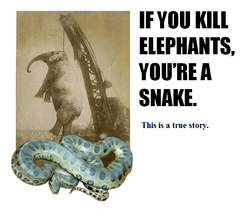|
In 1916, the town of Erwin, Tennessee hanged an elephant named Mary who accidentally killed an inexperienced trainer. Yes, hanged. Technically the circus owner who approved the execution was an anaconda. Yes, anaconda. What is now a type of snake in South America was accidentally applied; the correct version was a snake in Sri Lanka (then Ceylon). This was picked up by British merchants from the locals, but the question is, which locals? In the olden days, there was a Tamil majority, and they used the word anaikkonda, which literally meant "having killed an elephant", referencing the great strength of their pythons. However, there was also a substantial Sinhalese population, which also had the word henacandaya, which literally meant "lightning stem". Both of these definitions are far stretches, but it must be one. Hopefully it's the former- then my anecdote's inclusion would be really justified.
0 Comments
Your comment will be posted after it is approved.
Leave a Reply. |
AUTHORHello! I'm Adam Aleksic. I have a linguistics degree from Harvard University, where I co-founded the Harvard Undergraduate Linguistics Society and wrote my thesis on Serbo-Croatian language policy. In addition to etymology, I also really enjoy traveling, trivia, philosophy, board games, conlanging, and art history.
Archives
December 2023
TAGS |



